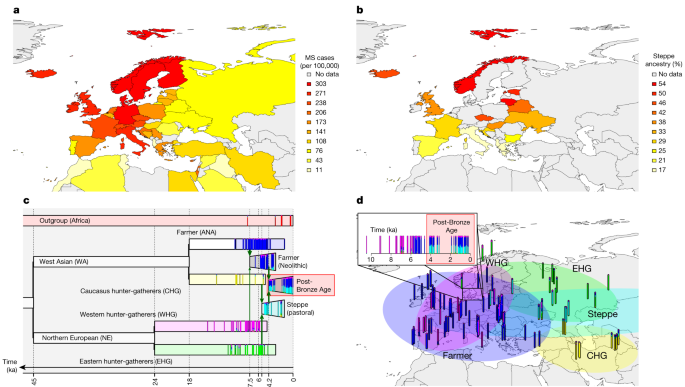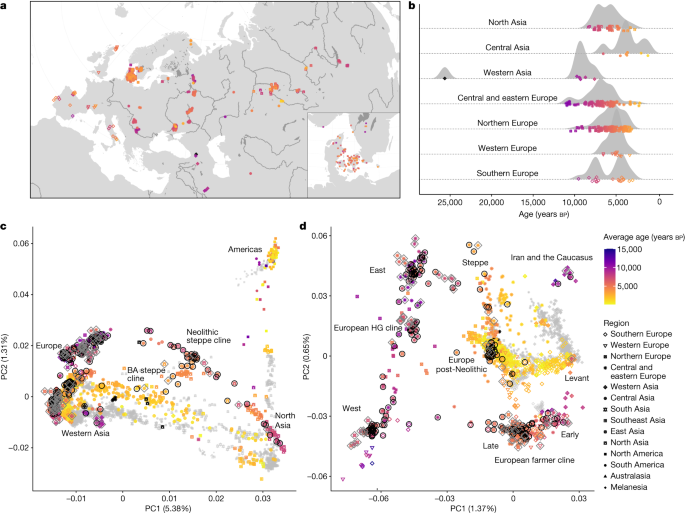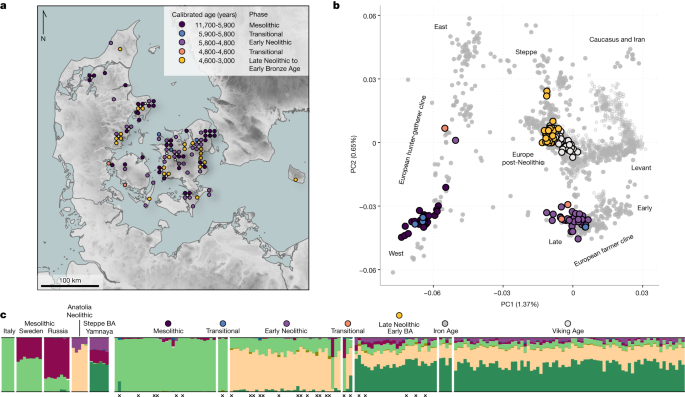2024-01-10 ケンブリッジ大学
◆この驚くべき結果は、ジャーナルNatureに掲載された4つの画期的な論文で明らかにされ、新たな生物学的理解を提供しています。この研究は、ケンブリッジ大学とコペンハーゲン大学のエスケ・ウィラーズレフ教授、コペンハーゲン大学のトーマス・ウェルジ教授、カリフォルニア大学バークレー校のラスムス・ニールセン教授を中心とする大規模な国際チームによって行われ、世界中の175人の研究者が貢献しました。
<関連情報>
- https://www.cam.ac.uk/stories/disease-spread-mapped-using-ancient-DNA#article
- https://www.nature.com/articles/s41586-023-06618-z
- https://www.nature.com/articles/s41586-023-06705-1
- https://www.nature.com/articles/s41586-023-06865-0
- https://www.nature.com/articles/s41586-023-06862-3
多発性硬化症の遺伝的リスクが草原の牧畜民集団で上昇 Elevated genetic risk for multiple sclerosis emerged in steppe pastoralist populations
William Barrie,Yaoling Yang,Evan K. Irving-Pease,Kathrine E. Attfield,Gabriele Scorrano,Lise Torp Jensen,Angelos P. Armen,Evangelos Antonios Dimopoulos,Aaron Stern,Alba Refoyo-Martinez,Alice Pearson,Abigail Ramsøe,Charleen Gaunitz,Fabrice Demeter,Marie Louise S. Jørkov,Stig Bermann Møller,Bente Springborg,Lutz Klassen,Inger Marie Hyldgård,Niels Wickmann,Lasse Vinner,Thorfinn Sand Korneliussen,Morten E. Allentoft,Martin Sikora,Kristian Kristiansen,Santiago Rodriguez,Rasmus Nielsen,Astrid K. N. Iversen,Daniel J. Lawson,Lars Fugger & Eske Willerslev
Nature Published:10 January 2024
DOI:https://doi.org/10.1038/s41586-023-06618-z

Abstract
Multiple sclerosis (MS) is a neuro-inflammatory and neurodegenerative disease that is most prevalent in Northern Europe. Although it is known that inherited risk for MS is located within or in close proximity to immune-related genes, it is unknown when, where and how this genetic risk originated1. Here, by using a large ancient genome dataset from the Mesolithic period to the Bronze Age2, along with new Medieval and post-Medieval genomes, we show that the genetic risk for MS rose among pastoralists from the Pontic steppe and was brought into Europe by the Yamnaya-related migration approximately 5,000 years ago. We further show that these MS-associated immunogenetic variants underwent positive selection both within the steppe population and later in Europe, probably driven by pathogenic challenges coinciding with changes in diet, lifestyle and population density. This study highlights the critical importance of the Neolithic period and Bronze Age as determinants of modern immune responses and their subsequent effect on the risk of developing MS in a changing environment.
古代ユーラシア人の選択景観と遺伝的遺産 The selection landscape and genetic legacy of ancient Eurasians
Evan K. Irving-Pease,Alba Refoyo-Martínez,William Barrie,Andrés Ingason,Alice Pearson,Anders Fischer,Karl-Göran Sjögren,Alma S. Halgren,Ruairidh Macleod,Fabrice Demeter,Rasmus A. Henriksen,Tharsika Vimala,Hugh McColl,Andrew H. Vaughn,Leo Speidel,Aaron J. Stern,Gabriele Scorrano,Abigail Ramsøe,Andrew J. Schork,Anders Rosengren,Lei Zhao,Kristian Kristiansen,Astrid K. N. Iversen,Lars Fugger,Peter H. Sudmant,Daniel J. Lawson,Richard Durbin,Thorfinn Korneliussen,Thomas Werge,Morten E. Allentoft,Martin Sikora,Rasmus Nielsen,Fernando Racimo & Eske Willerslev
Nature Published:10 January 2024
DOI:https://doi.org/10.1038/s41586-023-06705-1

Abstract
The Holocene (beginning around 12,000 years ago) encompassed some of the most significant changes in human evolution, with far-reaching consequences for the dietary, physical and mental health of present-day populations. Using a dataset of more than 1,600 imputed ancient genomes1, we modelled the selection landscape during the transition from hunting and gathering, to farming and pastoralism across West Eurasia. We identify key selection signals related to metabolism, including that selection at the FADS cluster began earlier than previously reported and that selection near the LCT locus predates the emergence of the lactase persistence allele by thousands of years. We also find strong selection in the HLA region, possibly due to increased exposure to pathogens during the Bronze Age. Using ancient individuals to infer local ancestry tracts in over 400,000 samples from the UK Biobank, we identify widespread differences in the distribution of Mesolithic, Neolithic and Bronze Age ancestries across Eurasia. By calculating ancestry-specific polygenic risk scores, we show that height differences between Northern and Southern Europe are associated with differential Steppe ancestry, rather than selection, and that risk alleles for mood-related phenotypes are enriched for Neolithic farmer ancestry, whereas risk alleles for diabetes and Alzheimer’s disease are enriched for Western hunter-gatherer ancestry. Our results indicate that ancient selection and migration were large contributor
氷河期後のユーラシア大陸西部の集団ゲノミクス Population genomics of post-glacial western Eurasias to the distribution of phenotypic diversity in present-day Europeans.
Morten E. Allentoft,Martin Sikora,Alba Refoyo-Martínez,Evan K. Irving-Pease,Anders Fischer,William Barrie,Andrés Ingason,Jesper Stenderup,Karl-Göran Sjögren,Alice Pearson,Bárbara Sousa da Mota,Bettina Schulz Paulsson,Alma Halgren,Ruairidh Macleod,Marie Louise Schjellerup Jørkov,Fabrice Demeter,Lasse Sørensen,Poul Otto Nielsen,Rasmus A. Henriksen,Tharsika Vimala,Hugh McColl,Ashot Margaryan,Melissa Ilardo,Andrew Vaughn,Morten Fischer Mortensen,Anne Birgitte Nielsen,Mikkel Ulfeldt Hede,Niels Nørkjær Johannsen,Peter Rasmussen,Lasse Vinner,Gabriel Renaud,Aaron Stern,Theis Zetner Trolle Jensen,Gabriele Scorrano,Hannes Schroeder,Per Lysdahl,Abigail Daisy Ramsøe,Andrei Skorobogatov,Andrew Joseph Schork,Anders Rosengren,Anthony Ruter,Alan Outram,Aleksey A. Timoshenko,Alexandra Buzhilova,Alfredo Coppa,Alisa Zubova,Ana Maria Silva,Anders J. Hansen,Andrey Gromov,Andrey Logvin,Anne Birgitte Gotfredsen,Bjarne Henning Nielsen,Borja González-Rabanal,Carles Lalueza-Fox,Catriona J. McKenzie,Charleen Gaunitz,Concepción Blasco,Corina Liesau,Cristina Martinez-Labarga,Dmitri V. Pozdnyakov,David Cuenca-Solana,David O. Lordkipanidze,Dmitri En’shin,Domingo C. Salazar-García,T. Douglas Price,Dušan Borić,Elena Kostyleva,Elizaveta V. Veselovskaya,Emma R. Usmanova,Enrico Cappellini,Erik Brinch Petersen,Esben Kannegaard,Francesca Radina,Fulya Eylem Yediay,Henri Duday,Igor Gutiérrez-Zugasti,Ilya Merts,Inna Potekhina,Irina Shevnina,Isin Altinkaya,Jean Guilaine,Jesper Hansen,Joan Emili Aura Tortosa,João Zilhão,Jorge Vega,Kristoffer Buck Pedersen,Krzysztof Tunia,Lei Zhao,Liudmila N. Mylnikova,Lars Larsson,Laure Metz,Levon Yepiskoposyan,Lisbeth Pedersen,Lucia Sarti,Ludovic Orlando,Ludovic Slimak,Lutz Klassen,Malou Blank,Manuel González-Morales,Mara Silvestrini,Maria Vretemark,Marina S. Nesterova,Marina Rykun,Mario Federico Rolfo,Marzena Szmyt,Marcin Przybyła,Mauro Calattini,Mikhail Sablin,Miluše Dobisíková,Morten Meldgaard,Morten Johansen,Natalia Berezina,Nick Card,Nikolai A. Saveliev,Olga Poshekhonova,Olga Rickards,Olga V. Lozovskaya,Olivér Gábor,Otto Christian Uldum,Paola Aurino,Pavel Kosintsev,Patrice Courtaud,Patricia Ríos,Peder Mortensen,Per Lotz,Per Persson,Pernille Bangsgaard,Peter de Barros Damgaard,Peter Vang Petersen,Pilar Prieto Martinez,Piotr Włodarczak,Roman V. Smolyaninov,Rikke Maring,Roberto Menduiña,Ruben Badalyan,Rune Iversen,Ruslan Turin,Sergey Vasilyev,Sidsel Wåhlin,Svetlana Borutskaya,Svetlana Skochina,Søren Anker Sørensen,Søren H. Andersen,Thomas Jørgensen,Yuri B. Serikov,Vyacheslav I. Molodin,Vaclav Smrcka,Victor Merts,Vivek Appadurai,Vyacheslav Moiseyev,Yvonne Magnusson,Kurt H. Kjær,Niels Lynnerup,Daniel J. Lawson,Peter H. Sudmant,Simon Rasmussen,Thorfinn Sand Korneliussen,Richard Durbin,Rasmus Nielsen,Olivier Delaneau,Thomas Werge,Fernando Racimo,Kristian Kristiansen & Eske Willersl
Nature Published:10 January 2024
DOI:https://doi.org/10.1038/s41586-023-06865-0

Abstract
Western Eurasia witnessed several large-scale human migrations during the Holocene1,2,3,4,5. Here, to investigate the cross-continental effects of these migrations, we shotgun-sequenced 317 genomes—mainly from the Mesolithic and Neolithic periods—from across northern and western Eurasia. These were imputed alongside published data to obtain diploid genotypes from more than 1,600 ancient humans. Our analyses revealed a ‘great divide’ genomic boundary extending from the Black Sea to the Baltic. Mesolithic hunter-gatherers were highly genetically differentiated east and west of this zone, and the effect of the neolithization was equally disparate. Large-scale ancestry shifts occurred in the west as farming was introduced, including near-total replacement of hunter-gatherers in many areas, whereas no substantial ancestry shifts happened east of the zone during the same period. Similarly, relatedness decreased in the west from the Neolithic transition onwards, whereas, east of the Urals, relatedness remained high until around 4,000 BP, consistent with the persistence of localized groups of hunter-gatherers. The boundary dissolved when Yamnaya-related ancestry spread across western Eurasia around 5,000 BP, resulting in a second major turnover that reached most parts of Europe within a 1,000-year span. The genetic origin and fate of the Yamnaya have remained elusive, but we show that hunter-gatherers from the Middle Don region contributed ancestry to them. Yamnaya groups later admixed with individuals associated with the Globular Amphora culture before expanding into Europe. Similar turnovers occurred in western Siberia, where we report new genomic data from a ‘Neolithic steppe’ cline spanning the Siberian forest steppe to Lake Baikal. These prehistoric migrations had profound and lasting effects on the genetic diversity of Eurasian populations.
新石器時代のデンマークで繰り返された集団の入れ替わりを示す100の古代ゲノム 100 ancient genomes show repeated population turnovers in Neolithic Denmark
Morten E. Allentoft,Martin Sikora,Anders Fischer,Karl-Göran Sjögren,Andrés Ingason,Ruairidh Macleod,Anders Rosengren,Bettina Schulz Paulsson,Marie Louise Schjellerup Jørkov,Maria Novosolov,Jesper Stenderup,T. Douglas Price,Morten Fischer Mortensen,Anne Birgitte Nielsen,Mikkel Ulfeldt Hede,Lasse Sørensen,Poul Otto Nielsen,Peter Rasmussen,Theis Zetner Trolle Jensen,Alba Refoyo-Martínez,Evan K. Irving-Pease,William Barrie,Alice Pearson,Bárbara Sousa da Mota,Fabrice Demeter,Rasmus A. Henriksen,Tharsika Vimala,Hugh McColl,Andrew Vaughn,Lasse Vinner,Gabriel Renaud,Aaron Stern,Niels Nørkjær Johannsen,Abigail Daisy Ramsøe,Andrew Joseph Schork,Anthony Ruter,Anne Birgitte Gotfredsen,Bjarne Henning Nielsen,Erik Brinch Petersen,Esben Kannegaard,Jesper Hansen,Kristoffer Buck Pedersen,Lisbeth Pedersen,Lutz Klassen,Morten Meldgaard,Morten Johansen,Otto Christian Uldum,Per Lotz,Per Lysdahl,Pernille Bangsgaard,Peter Vang Petersen,Rikke Maring,Rune Iversen,Sidsel Wåhlin,Søren Anker Sørensen,Søren H. Andersen,Thomas Jørgensen,Niels Lynnerup,Daniel J. Lawson,Simon Rasmussen,Thorfinn Sand Korneliussen,Kurt H. Kjær,Richard Durbin,Rasmus Nielsen,Olivier Delaneau,Thomas Werge,Kristian Kristiansen & Eske Willerslev
Nature Published:10 January 2024
DOI:https://doi.org/10.1038/s41586-023-06862-3

Abstract
Major migration events in Holocene Eurasia have been characterized genetically at broad regional scales1,2,3,4. However, insights into the population dynamics in the contact zones are hampered by a lack of ancient genomic data sampled at high spatiotemporal resolution5,6,7. Here, to address this, we analysed shotgun-sequenced genomes from 100 skeletons spanning 7,300 years of the Mesolithic period, Neolithic period and Early Bronze Age in Denmark and integrated these with proxies for diet (13C and 15N content), mobility (87Sr/86Sr ratio) and vegetation cover (pollen). We observe that Danish Mesolithic individuals of the Maglemose, Kongemose and Ertebølle cultures form a distinct genetic cluster related to other Western European hunter-gatherers. Despite shifts in material culture they displayed genetic homogeneity from around 10,500 to 5,900 calibrated years before present, when Neolithic farmers with Anatolian-derived ancestry arrived. Although the Neolithic transition was delayed by more than a millennium relative to Central Europe, it was very abrupt and resulted in a population turnover with limited genetic contribution from local hunter-gatherers. The succeeding Neolithic population, associated with the Funnel Beaker culture, persisted for only about 1,000 years before immigrants with eastern Steppe-derived ancestry arrived. This second and equally rapid population replacement gave rise to the Single Grave culture with an ancestry profile more similar to present-day Danes. In our multiproxy dataset, these major demographic events are manifested as parallel shifts in genotype, phenotype, diet and land use.


